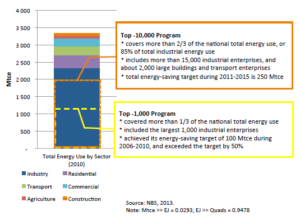
The Top 1,000 Energy-Consuming Enterprises Program, which targeted the largest 1,000 enterprises in China, successfully achieved and surpassed its energy-saving target of 100 milliion tons of coal equivalent (Mtce) during the 11th FYP with reported savings of just over 150 Mtce. During the 11th FYP, the Top 1,000 Program was gradually expanded at the local level. Provinces established energy conservation programs to cover smaller enterprises in the local “Double-Hundred” programs or provincial “Top 1,000” programs. This built the foundation for expanding the Top 1,000 program to the Top 10,000 Program under the 12th FYP.
The Top 10,000 Program aims to cover two thirds of China’s total energy consumption, or 15,000 industrial enterprises that use more than 10,000 tonnes of coal equivalent (tce) per year, and around 160 large transportation enterprises (such as large shipping companies), and public buildings that use more than 5,000 tce per year. The total number of enterprises covered by this program reaches to around 17,000.
The target of the Top 10,000 Program is an absolute energy-saving target of 250 Mtce by 2015. To achieve the 16% energy intensity reduction relative to 2010 (economic energy intensity, i.e., energy consumption over GDP), the total energy-saving target for China is 670 Mtce (assuming GDP growth of 8.5% per year). This means the share of the energy-saving target of the Top 10,000 Program is 37% of the total energy-saving target.
The 250 Mtce saving target will be disaggregated to local provinces and cities. The target setting process is said to be the following:
- Local companies report their estimated energy-saving potentials to the local government
- Local provinces estimate total energy-saving targets for their provinces and submit their proposed targets to the central government
- The central government reviews the proposed target.
- Provincial and central governments negotiate the targets before final targets are determined.
Local governments will evaluate local enterprises’ progress toward their energy-saving target and publicize the results. For the enterprises that do not meet their annual energy-saving target, mandatory energy audits will be conducted and adjustment/retrofits will be required. Local governments are authorized to supervise the progress of local enterprises, as well as supervise centrally owned large State-Owned Enterprises.
The key elements of the Top 10,000 Program include:
- establishment of energy conservation working groups in enterprises,
- implementation of the target responsibility and accounting system, allocating targets to companies, plants and workshops,
- conducting energy audits and developing energy conservation plans, based on the Technical Principle of Energy Audits in Enterprises (GB/T 17166),
- implementation of energy audit systems,
- conducting energy efficiency benchmarking,
- – establishment of energy management systems following China's energy management standard (GB/T 23331),
- expansion of the energy managers training pilots,
- implementation of energy utilization reporting system,
- continuation of phasing-out of backward technologies,
- acceleration of energy conservation retrofits by allocating special funding for annual retrofits and cooperating with ESCOs,
- improvement of energy measurement and measuring instrument, encouraging companies to build energy management and control centers and to use automation and IT, and
- establishment of energy conservation incentive mechanisms
A Case Study A Steel Mill in China
By focusing on a process heating energy system assessment conducted in a Chinese steel mill, this paper presents an example of an energy system assessment conducted on steel reheating furnaces. In addition, the paper provides energy-savings recommendations that were identified during the assessment, as well as potential energy and energy costs savings. To conclude, this paper presents key findings that could further improve the Top 10,000 program.
Sources
Industrial Efficiency Policy Database. SourcesTop-10,000 Energy-Consuming Enterprises Program.
ECEEE. Energy assessments under the Top 10,000 Program – a case study for a steel mill in China.